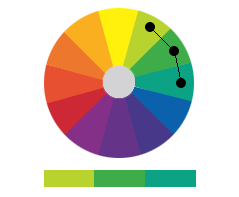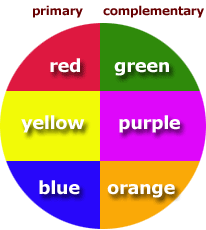syllabus | assignments | resources | home
SUNY ULSTER
DEPARTMENT OF ART, DESIGN, MUSIC, THEATRE & COMMUNICATION
ART 150 Two Dimensional Design Instructor: DINA ALCALAY PEARLMAN
IN-CLASS AND HOMEWORK NOVEMBER 16, 2011: choosing a color scheme
PROBLEM: Exploring different color schemes
MAJOR 2-D Elements & Concepts (refer to your handout for definitions:
Principle Element: Color
Vocabulary: color wheel, analogous color, monochromatic color, complementary color, shades, tints, hue, value and intensity
DETAILS: You will be given a print-out of a black and white still-life photograph. (can also be viewed at http://www.wordimagemedia.com/neg-space/Color/AAdams_StillLife1932.jpg
From this, create a small still-life painting using one of the two types of color schemes:
Analogous color scheme* OR
Complimentary color scheme* (choose one set and as many tints and shades of each, for example: violet and yellow and any variation of intensity of these two colors.)
*(refer to your vocabulary lists and handouts from Monday)
MATERIALS: choose one of the following for your painting surface: Illustration board, canvas board or heavy duty paper (**see additional instructions for paper below), acrylic paint, acrylic medium
SIZE: 9 x 12 up to 11 x 14
First step:
Research
a MINIMUM of one of the following artists for inspiration and discussion: Van Gogh, Matisse, Picasso, Gaugain, or the Fauvist art movement. Bring in one example of a painting; either print out, take a book out from the library, or supply the web address in an email to me. We will look at them in class together. Please consider how the artist used color to enhance his or her painting, what mood does color provide. This is part of your homework assignment.
Second step: In your sketchbook:
Using pencil or charcoal, recreate the attached still-life focusing primarily on value.
Create three ideas for color schemes using swatches painted in your sketchbook.
Third step: Choose one color scheme from the three you’ve experimented with, and create your final painting on your painting surface. It does not have to have every detail, but focus on shape, filling the picture plane, and most importantly, assigning colors from your color-scheme to the various values seen in the black and white photograph.
**Considerations:
If you are using paper, it must be heavy, such as a bristol or water-color paper. Try taping the paper to a table to keep it flat while you paint.
Minimum Requirements:
a) one (1) small painting to present in class.
a minimum of one still-life recreation in pencil or charcoal)
three (3) sets of swatches of color schemes in your sketchbook. You will be showing these with your painting.
DUE: Monday November 21.
Analogous Colors
Complementary Colors |
|


